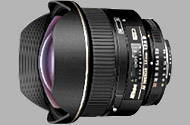 |
AF 14 mm f/2.8 Nikkor ED-RF |
Wide Horizons: The AF 14 mm f/2.8 Nikkor ED-RF
By Bjørn Rørslett
Review date 27 August, 2000
It simply had to happen. D1 users would never end their quest for wider angles of view than that offered by the superb AFS 17-35/2.8 Nikkor. For once, Nikon apparently listened to their customers and recently came up with this spectacular ultrawide-angle. It has a 92 degrees angle of view (equivalent to a 21 mm lens) on a D1. Picture angle on a full-frame camera is around 114 degrees, so it really takes in nearly everything in front of the camera.
I was fortunate - once again - to get hold of an early sample to give it a spin under field conditions. This is an advanced design of 14 elements in 12 groups, comprising moulded aspherical and ED glass elements. It has a rear-focusing (RF) system and the near limit is a remarkable 0.2 m. There is a non-removable, scalloped metal hood and the exterior has the same smooth finish as the 17-35 lens.
 |
AF 14 mm f/2.8 Nikkor ED-RF |
The 14 mm itself is fairly short, but surprisingly heavy at 640 g. It is completely dominated by its huge, bulbous front element shimmering in remarkable golden and blue-green hues. You cannot attach filters to the front end, however, there is a small gel filter slot at the rear. Nikon opted for the traditional AF mechanism instead of an AFS system. Probably no benefit would accrue from AFS anyway, because the focusing throw is so short and AF focusing is very swift indeed on the D1 and F5 bodies. Noise during focusing is absolutely minimal, too. In common with e.g. the AF Nikkor 85 mm f/1.8, this lens uses a variant of the IF (internal focusing) method called "RF" (Rear focusing).
I tested the AF 14 mm using my routine setup as outlined under the 'Lens Evaluation' section. As set forth with the 85 PC Micro-Nikkor, my results are summarised graphically as depicted in the graph below. The graphical presentation aims to augment, not replace, the exhaustive written comments on each lens. Please bear in mind that no lens can achieve an 'Outstanding' or 'Excellent' quality when it is stopped well down because of the adverse effects of diffraction. Performance at each aperture in this graph is not weighted according to the maximum possible, so any lens will show a declining pattern towards its minimum aperture. I simply evaluate the test results in terms of what one should like to see in image quality, were the aperture setting not known.
The digital images on the D1 were captured using 12-bit raw files from the camera which were converted into TIFF format with Bibble (v. 1.99a). For the F5 shooting, I used Provia F.
|
| (evaluated on a D1) |
|
| (on the F5) Subjective evaluation of the AF 14 mm f/2.8 Nikkor ED-IF. See text for details. |
Why are the graphical results for the 14 mm Nikkor so different between D1 and F5? The reason simply is that D1 uses a smaller, central part of the image circle than a 35 mm camera and thus, maximises the optical performance of this ultrawide lens. For the lenses I've tested before, this issue hasn't been present to any significant degree. There is also the problem of assigning correct weight to the peripheral zones on the full-frame image. For a number of applications, reduced corner performance is of no great concern. On the other hand, for architectural and flat-field work, the entire frame may be needed. I prefer to take a "worst-case" , conservative approach and averaging performance across the entire frame. In the case of the Nikkor 14 mm, this gives a performance "penalty" that may or may not be significant contingent upon the type of shooting and subjects involved. Please interpret the graphical results with this caveat in mind.
On-axis, the 14 mm lens delivers exceptional sharpness and contrast even wide open, and this quality is further enhanced upon stopping down a few stops. It outperforms the AFS 17-35 Nikkor (set to 17 mm) by a comfortable margin at f/2.8-f/4. Central image quality persists up to the f/11-f/16 range, but the image softens significantly at f/22, again as anticipated, due to diffraction. Colours are rendered vividly saturated, probably thanks to the ED glass incorporated in the lens design. On the D1, uneven illumination is just perceptible at f/2.8 and negligible once the aperture setting is moved from a wide-open position. However, this is not the case on the F5, in which situation the extreme image corners are visibly darker (approx. -1.3 EV) at f/2.8. Stopping down improves image evenness and at f/5.6-f/8, vignetting is of little practical significance.
Slides obtained with the 14 mm Nikkor on F5 exhibited some softness into the extreme frame corners that disappeared by f/5.6. This is partly due to field curvature, a persistent issue with all wide-angle lenses. Residual coma and spherical aberration may also come into play. I found an unexpected decline of sharpness in the intermediate image zone (halfway between the centre and corners), at settings around f/5.6. This problem would not show up in the D1 images, though. Although unusual, such performance declines do occur in other lenses and the 400 mm f/3.5 Nikkor springs to mind in this connection. From f/8 onwards, the entire frame is crisp and sharp corner to corner. Softening at f/22 is evident, but there is plenty of image detail even into the corners at this setting. Colour fringing occurs quite sparingly, but in this respect the 14 mm Nikkor does not perform equally well as the AFS 17-35 lens.
Geometric distortion is bound to be present on any wide-angle lens with a retrofocus optical design, and the AF 14 mm Nikkor is no exception to this rule. Basically, there is barrel-type distortion that changes to a "wave-like" pattern into the extreme corners. I've seen the apt description "moustache distortion" applied to this response. It is of some concern when you do architecture-type work, but as I detected later on, may not be very visible for a fairly broad range of subjects. Whether or not this bizarre distortion is important is entirely determined by the way you shoot. And on D1, it will never show up, here a slight barrel distortion is all you'll ever see.
Shooting under adverse, back-lighted conditions reveals that the 14 mm Nikkor displays some flaring. However, it is remarkably better than the earlier 15 mm Nikkors in this respect. Ghosting is only to be expected given its 14 element design, but in fact, is less prominent than you would imagine. Again, there is a difference whether the lens is deployed on a digital or film-based camera, the ghosting being much less of an issue on the D1.
|
| These fern leaves contain
a true wealth of detail which is effortlessly captured
with the new AF 14 mm Nikkor. Image taken on D1 (f/11,
0.3 m distance). Note the complete lack of light fall-off
and the crisp image details. Web presentation cannot possibly do justice to these sharp images. To underscore this point, take a look at the tiny detail presented below. |
|
The near focusing limit, 0.2m, of the AF 14 mm makes for truly steep perspectives in close-ups. The front element then is just 5-6 cm away from the subject. A judicious use of the ultra-thin K1 ring enables even steeper perspectives, but beware of bumping the exposed lens surface into your subject as there scarcely is any free space in front of the lens. In addition, Nikon warns against using the K1 ring with the 14 mm in their leaflet accompanying the lens, so you are entirely on your own here. An example of the extreme perspective attainable is given by the image below,
 Picking cowberries |
| © Bjørn Rørslett/NN |
I found the AF 14 mm f/2.8 Nikkor ED-IF a very valuable addition to the lens arsenal of any D1 shooter, and it undoubtedly will tempt a great number of F100/F5 users as well. This is a lens I could live comfortably with, despite its shortcomings in some areas. In fact, I couldn't resist purchasing my own 14 mm lens soon after completing this review ...
For use on a D1, I rate this lens '5' (Excellent), while it can only get a rating of '4' (very good) for film-based cameras due to the off-axis problems detailed above. On whatever camera it is put to service, it certainly will deliver images with great pictorial impact.
A final note of warning (added after I got my D1X camera): The AF 14 mm does not behave to its advantage on this higher-resolution digital camera. There is some loss of colour fidelity with accompanying traces of colour fringing in the off-axis image. If you plan to use the AF 14 mm on a D1X, be sure to shoot some test images to assess whether or not this is acceptable for you. Photojournalists probably won't care but I for one certainly do.
However, tt is possible to mitigate the colour fringing issues to a large extent, by using digital wizardry provided by software such as Panorama Tools. Refer to the Tutorial provided by Brian Caldwell for pointers to the methods involved.